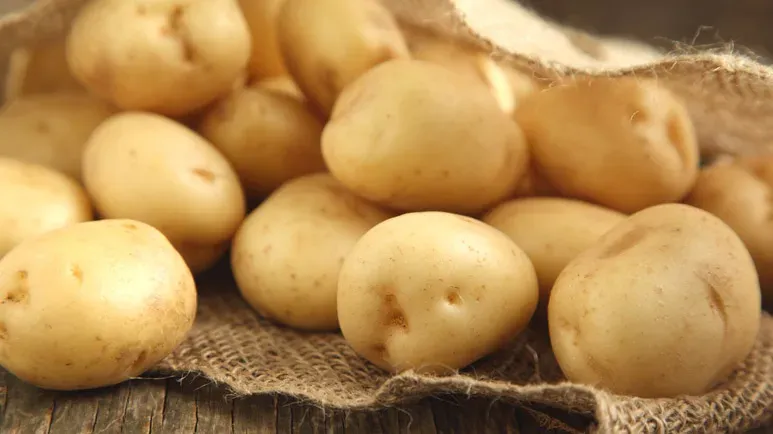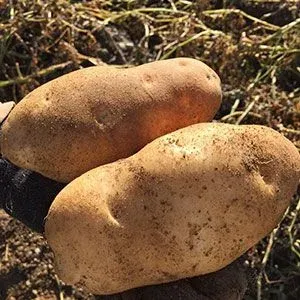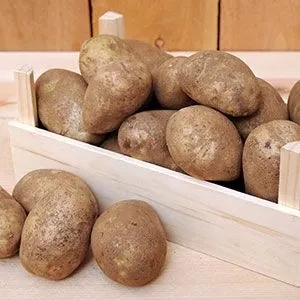Russet Potato: Mash Up Your Pet's Diet with This Gem
A staple in many kitchens, this tuber may protect against oxidative stress and inflammation, according to research. However, remember to feed it in moderation.

STORY AT-A-GLANCE
- Cooked then mashed or cut into bite-sized pieces, russet potatoes are safe for pets to consume. However, they contain high amounts of carbohydrates, so it’s best to offer them in limited amounts
- Russet potatoes are abundant in flavonoids, the most predominant of which are catechins, powerful antioxidants. They also contain kaempferol, quercetin, myricetin as well as carotenoids
- You can add small amounts of russet potato to your pet’s nutritionally balanced, species-appropriate diet as a treat or a food topper, keeping in mind that healthy treats should only make up less than 10% of your pet’s daily caloric intake
- When buying russet potatoes, choose those that are firm and smooth, with no bruises, discolorations or cuts
- Soaking potatoes overnight and boiling them thoroughly before feeding them to your pet helps mitigate their antinutrient content
Editor's Note: This article is a reprint. It was originally published December 20, 2022.
Named for its color, the russet potato (Solanum tuberosum) is a widely known potato cultivar that’s often large in size with patchy brown skin and starchy white flesh. It’s a staple in many cuisines around the world, but can dogs and cats eat it as well?
The short answer is yes — russet potatoes are safe for pets to consume. However, they contain high amounts of carbohydrates, aka starch (sugar), which dogs and cats have no biological need for. So if you must feed your pet russet potatoes, it’s best to offer them sparingly (more about this later). Continue reading to find out more about russet potatoes, the role they play in the pet food industry and how to offer them to your furry friend.
Fun Fact About Russet Potatoes

Potatoes have been around since 6000 BC, but it wasn’t until the 1870s that russet potatoes were hybridized by Luther Burbank, a farmer in Massachusetts — hence why russet potatoes are also called Russet Burbank.1
Russet Potatoes Are Abundant in Flavonoids and Starch
According to a study published in the American Journal of Potato Research, white-fleshed potatoes like the russet contain up to 30 micrograms of flavonoids per 100 grams of fresh weight,2 the most predominant of which are catechins. These are powerful antioxidants that may help protect your pet from cellular damage caused by oxidative stress.3
Kaempferol, quercetin and myricetin are also present in russet potatoes.4 Kaempferol, in particular, exhibits antioxidant, anti-inflammatory and anticarcinogenic properties.5 Animal studies have also demonstrated its neuroprotective effects.6 The same can be said for quercetin, which was found to help improve cognition and memory in studies involving mice with Alzheimer’s disease.7
As for myricetin, this compound has a wide array of pharmacological properties, including antimicrobial, antioxidant, neuroprotective, anti-inflammatory and immunomodulatory activities, among others.8
“However, even though potatoes provide an array of bioactive compounds, they still should not make up a large portion of your pet’s diet because they’re high in starch.”
One important caveat about russet potatoes is their high starch content. In fact, they’re known to be one of the starchiest potato variants, which is why they’re a popular choice for mashed or baked potato dishes for humans.9 Starches are carbohydrates that are not essential to dogs’ and cats’ diets, as these pets do not have a biological need for them.
Carbohydrate-containing foods can be classified according to their glycemic index, which is a measure of how much their carbs can affect blood sugar levels.10 A medium baked russet potato has a high glycemic index of 111,11 which means it provides excessive sugar that can cause metabolic stress, elevate your pet’s blood sugar levels and put their body in a proinflammatory state in the long run.
If the bulk of your pet’s calories come from high-glycemic foods like potatoes, it can set them up for health challenges, particularly metabolic ones that result in systemic inflammation and obesity. So should you decide to give russet potato to your pet, only add small amounts of it as an ingredient to their nutritionally balanced, species-appropriate homemade meal, or offer it as an occasional treat or a food topper.
These Spuds Offer Phenolic Compounds
Russet potatoes contain high amounts of phenolic acids, particularly chlorogenic acid, which have antidiabetic, anticarcinogenic and anti-inflammatory properties.12 Another notable phenolic compound in these tubers is ferulic acid, which may exhibit neuroprotective effects.13 According to a meta-analysis published in the journal Cells, ferulic acid helped improve spatial memory ability in animal models and reduced beta-amyloid deposition, which is one of the pathological hallmarks of Alzheimer’s disease.14
Russet Potato Trivia

Russet potatoes are one of the most widely consumed potato varieties, accounting for about 70% of potato sales in the U.S.15
Russet Potatoes Are Starchy, So Feed in Small Amounts
Starch is converted into sugar in your pet’s body. A starch-heavy diet can set the stage for a host of degenerative diseases. For this reason, it’s not recommended to feed starch to pets “just because.” But if you must add carbs to their diet for medical reasons (for instance, during a dog’s pregnancy) or due to financial constraints, keep in mind that active dogs can tolerate only up to 20% starch in their diet without experiencing significant metabolic consequences. So try to limit their carb intake to that amount.
If your goal is to optimize your pet’s metabolic well-being and longevity, then the less carbs from starch that you include in their diet the better. Prioritize calories that resonate with your pet’s innate metabolic machinery — lean meats and healthy fats. If you need to add carbs to their diet, choose low-glycemic, fiber-rich carbs like sprouted rolled oats.
Again, should you decide to feed russet potatoes, you can use them as an ingredient in a nutritionally balanced homemade meal or as a treat or food topper. Keep in mind that healthy treats should only make up less than 10% of your pet’s daily caloric intake.
Antinutrients in Russet Potatoes
Before sharing russet potatoes with your pet, it’s important to be aware of their antinutrient content. Antinutrients are natural compounds that plants produce to protect themselves from insects, bacteria and fungi. However, in humans and animals, these compounds can bind to critical nutrients and interfere with their digestion and absorption in the gut.16 Some of the antinutrients found in russet potatoes are oxalic acid,17 lectins,18 saponins,19 isoflavones and tannins.20
Fortunately, proper food preparation techniques can help lower the antinutrients in potatoes should you decide to share them with your pet. Soaking potatoes overnight and boiling them thoroughly before feeding them to your pet helps mitigate their antinutrient content.
How to Choose Safe and Sustainably Grown Russet Potatoes
Potatoes are one of the most economically important crops in the world. In the U.S. alone, a total of 1 million acres of potatoes were harvested in 2020.21 Among all potato varieties, russet potatoes have the highest yield and sales.22,23 Potato cultivation is so large-scale that it’s even believed to have set the template for modern industrial agriculture.24
Sadly, that means conventionally grown russet potatoes might be cultivated through unsustainable farming practices, including monocropping and using pesticides.25 While potatoes are not included in the Environmental Working Group’s Dirty Dozen list, they’re also not in the Clean Fifteen.26 This means that conventionally grown potatoes may still have pesticide residues. Exposure to pesticides has been linked to an increased risk of cancer in humans and animals.27
To make sure you’re not exposing your family, including the furry family members, to harmful agricultural chemicals, choose organic, spray-free russet potatoes as much as possible. Check your local farmers market and buy from trustworthy sources that utilize sustainable farming practices.
Which State Produces the Most Russet Potatoes?

Idaho leads the production of russet potatoes in the U.S., accounting for about 30% of the country’s russet harvest. This is why russet potatoes are sometimes called Idaho potatoes. Other top-producing states are Washington, Wisconsin, Colorado and North Dakota.28,29

Should You Worry About Solanine in Russet Potatoes?
Misinformation about many healthy fruits, vegetables, nuts and seeds abounds on the internet. This is because websites have labeled all risks (such as the risk of overconsumption causing gastrointestinal issues, or choking on too large of pieces or pits) as “toxicities,” which isn't true but has managed to confuse millions of pet lovers, nonetheless.
In the case of potatoes, you may have heard of poisoning cases involving one of its compounds: solanine. Solanine is a glycoalkaloid naturally found in potatoes and other plants belonging to the nightshade family. It’s especially concentrated on the leaves, flowers and sprouts of potatoes, while the skin and flesh only have low levels. However, solanine concentration increases when potatoes are exposed to light for prolonged periods,30 making the sprouts (or “eyes”).
When excessive solanine is consumed, it can damage cell membranes and inhibit an enzyme that plays a role in the breakdown of neurotransmitters, causing gastrointestinal and systemic effects in both humans and animals.31 However, you don’t need to be scared of serving potatoes to your family, because there are many ways for you to avoid illness related to solanine, starting by being mindful of the potatoes you choose at the grocery store and preparing them correctly.
How to Choose and Serve Russet Potatoes to Pets
When buying russet potatoes, choose potatoes that are firm and smooth, with no bruises, discolorations or cuts. As much as possible, choose potatoes that have no sprouts. If you do buy one that has sprouted, it’s OK — just make sure you remove those tiny growths before cooking. Potatoes that have turned green, on the other hand, should definitely be avoided and discarded. The green hue is a sign that they’ve been exposed to light and have likely produced too much solanine.32
Fortunately, green potatoes are usually rejected before they make it to the market. If you have potatoes at home, proper storage is key to keeping them from developing high solanine levels. Make sure you store them in a well-ventilated place that’s cool, dry and dark to prevent them from sprouting and turning green.33
Before offering russet potatoes to your pet, soak them overnight and cook them to reduce their antinutrient content. You can boil or steam the vegetable, then mash, puree or chop it into bite-sized pieces that your pet can comfortably and safely chew and swallow. You can serve potato with its peel on, as it contains a large portion of the tuber’s bioactive compounds. But since the peel has more oxalate and solanine, make sure you boil it first.
Again, if you’re going to use russet potatoes as a treat, remember to limit the serving of healthy snacks to less than 10% of your pet’s daily caloric intake. If your pet is predisposed to calcium oxalate bladder stones, it’s best to restrict their consumption of veggies with high oxalate content to less than 2% of your homemade recipe ingredients, and use them sparingly as training treats.
The Issue of Potatoes (and Other Starches) in Pet Food
If you feed your pet dry food, look closely at the ingredients list. You might find potato there, along with other sources of carbohydrates, including oatmeal, sweet potato, lentils, peas (pea starch), chickpeas, tapioca or other starches and grains. These carbs are necessary for kibble to stick together during the extrusion process.
Although they’re often marketed as rich sources of “energy,” calories coming from unnecessary carbs offset the amount of lean, healthy protein and high-quality fats that should comprise dogs’ and cats’ diets. Pet food manufacturers also use excessive legumes because it’s a cheaper way to boost the protein content in their formula than using real meat.
This excessive carbohydrate content, coupled with plant-based proteins that lack vital nutrients pets need to obtain from foods (such as taurine), can lead to nutritional deficiencies over time, resulting in health problems. This is why, as much as possible, you should feed your pet a species-appropriate, minimally processed, fresh, whole food diet that’s low-starch and grain-free.
Do This Equation to Determine the Carb Content in Kibble
While we’re on the topic of potatoes being used as fillers in ultraprocessed pet food, below is a carb equation that you should always keep in mind if you must purchase dry pet food. It will help make sure your animal companion is receiving an adequate amount of meat-derived protein instead of just unnecessary carbs that do nothing for their health.
In some pet food labels, the carb content is intentionally not listed. To determine the carb content, find the Guaranteed Analysis on the side of the dry pet food bag (it will list the amount of protein, moisture, fat and ash in the food), then do this simple math equation:
Example, cat food: Royal Canin Indoor Adult Dry Cat Food34
Example, dog food: Royal Canin Medium Adult Dry Dog Food35
Again, the goal is to keep all carbs to less than 20% of your pet’s diet, as this is the least metabolically stressful for pets. If you need to give them carbs due to financial or medical reasons and are considering offering them russet potatoes, make sure to offer them only in small amounts. Although it might not be the most biologically appropriate food for your animal companion, it may still impart some beneficial nutrients and is not toxic to consume when prepared properly.
Sources and References
- 1 University of Nebraska-Lincoln, Russet Burbank: Characteristics (Archived)
- 2 American Journal of Potato Research Volume 82, Pages 163–172 (2005)
- 3,13,20 Int J Mol Sci. 2016 May 27;17(6):835
- 4 Antioxidants 2022, 11(4), 603, Diversity of Polyphenols in Potato
- 5 J Funct Foods. 2017 Jan 18;30:203–219
- 6 Front Pharmacol. 2021 Jan 13;11:565700
- 7 Int J Mol Sci. 2020 Jan; 21(2): 493
- 8 BMC Complementary Medicine and Therapies, Volume 20, Article number: 241 (2020)
- 9 Nutrients. 2018 Nov 14;10(11):1764
- 10 Mayo Clinic, November 2, 2022
- 11 Oregon State University, Glycemic Index and Glycemic Load
- 12 Eur J Nutr. 2017 Oct;56(7):2215-2244
- 14 Cells. 2021 Oct 5;10(10):2653
- 15,23 Master Class, August 11, 2021
- 16 Harvard School of Public Health, Are Anti-Nutrients Harmful?
- 17 The University of Chicago, November 16, 2015
- 18 Biochem J. 1978 Jun 1;171(3):665-674
- 19 Phytochemistry. Volume 46, Issue 6, November 1997, Pages 1005-1009
- 21 Agricultural Marketing Resource Center, Potatoes
- 22 Spudsmart, July 5, 2021
- 24,25 FoodPrint, Potatoes
- 26 EWG, EWG's 2024 Shopper's Guide to Pesticides in Produce™ - Full List
- 27 Environmental Health Volume 19, Article number: 18 (2020)
- 28 Idaho State University, June 26, 2017
- 29 Wisconsin Department of Public Instruction, Potato
- 30 Ask USDA, August 23, 2024
- 31 Regul Toxicol Pharmacol. 2005 Feb;41(1):66-72
- 32 Food Network, December 22, 2023
- 33 Potato Goodness, How to Pick a Potato
- 34 Amazon, Royal Canin Indoor Adult Dry Cat Food
- 35 Amazon, Royal Canin Medium Breed Adult Dry Dog Food











